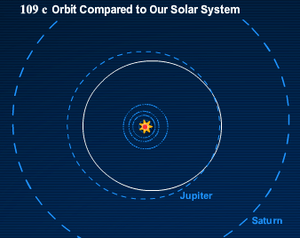OGLE-2006-BLG-109Lc
| Exoplanet | List of exoplanets | |
|---|---|---|
 Jupiter's orbit (5.2AU) in our Solar System. | ||
| Parent star | ||
| Star | OGLE-2006-BLG-109L | |
| Constellation | Sagittarius | |
| Right ascension | (α) | 17h 52m 35s |
| Declination | (δ) | –30° 05′ 16″ |
| Apparent magnitude | (mV) | 17.17 |
| Distance | 4,920 ± 390 ly (1,510 ± 120 pc) | |
| Observed separation | ||
| Projected separation | (d) | 4.5 ± 1 AU |
| Orbital elements | ||
| Eccentricity | (e) | 0.15 ± 0.1 |
| Orbital period | (P) | 4931 ± 1750 d (13.5 ± 4.79 y) |
| Inclination | (i) | 64 ± 8° |
| Physical characteristics | ||
| Mass | (m) | 0.271 ± 0.022 MJ (85.8 ± 9.5 M⊕) |
| Temperature | (T) | 59 ± 7 |
| Discovery information | ||
| Discovery date | 14 February 2008 | |
| Discoverer(s) | Gaudi and Bennett et al. | |
| Discovery method | Gravitational microlensing | |
| Discovery status | Published | |
| Other designations | ||
EWS 2006-BUL-109Lc | ||
| Database references | ||
| Extrasolar Planets Encyclopaedia | data | |
| SIMBAD | data | |
| Exoplanet Archive | data | |
| Open Exoplanet Catalogue | data | |
OGLE-2006-BLG-109Lc is an extrasolar planet approximately 4,920 light-years away in the constellation of Sagittarius. The planet was detected orbiting the star OGLE-2006-BLG-109L in 2008 by a research team using Microlensing. The host star is about 50% the mass of the Sun and the planet is about 90% the mass of Saturn.[1][2]
See also
References
- ↑ "Discovery of a Jupiter/Saturn Analog in OGLE-2006-BLG-109". MicroFUN (Microlensing Follow-Up Network). Retrieved 2008-06-27.
- ↑ Gaudi, B. S.; et al. (2008). "Discovery of a Jupiter/Saturn Analog with Gravitational Microlensing". Science. 319 (5865): 927–930. arXiv:0802.1920. Bibcode:2008Sci...319..927G. doi:10.1126/science.1151947. PMID 18276883.
|first2=missing|last2=in Authors list (help)
External links
- Britt, Robert Roy (2008-02-14). "Solar System Like Ours Found". Space.com. Retrieved 2008-06-27.
- Dominik, Martin (2006-02-11). "The unlonely planets — Discovery of a Jupiter/Saturn analogue". ARTEMiS. Retrieved 2008-06-27.
- Overbye, Dennis (2008-02-14). "Scientists Find Solar System Like Ours". The New York Times. Retrieved 2008-06-27.
- Rincon, Paul (2008-04-06). "Solar System's 'look-alike' found". BBC News. Retrieved 2008-06-27.
Coordinates: ![]()
This article is issued from
Wikipedia.
The text is licensed under Creative Commons - Attribution - Sharealike.
Additional terms may apply for the media files.